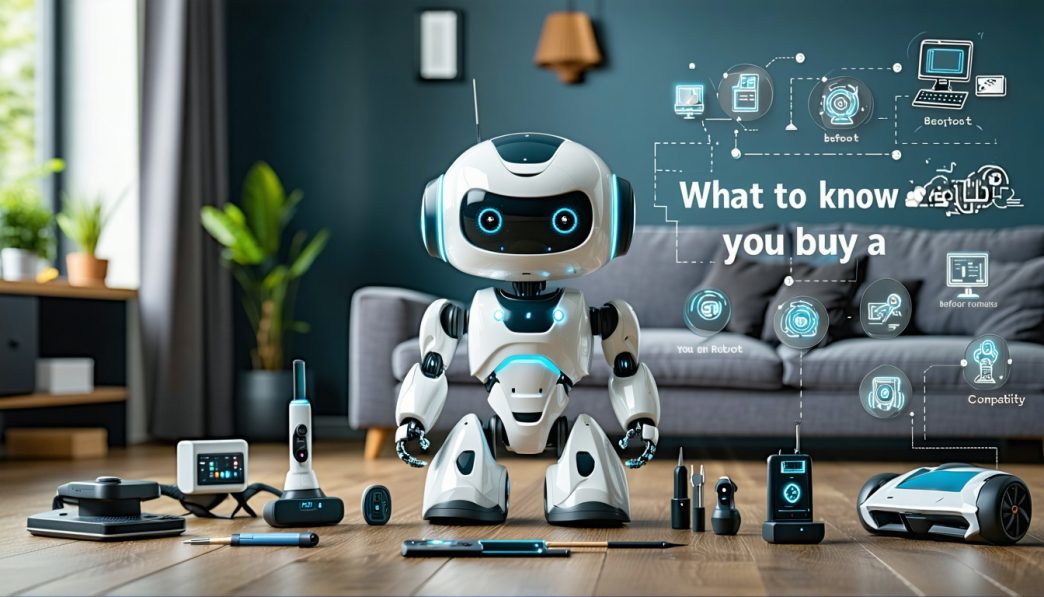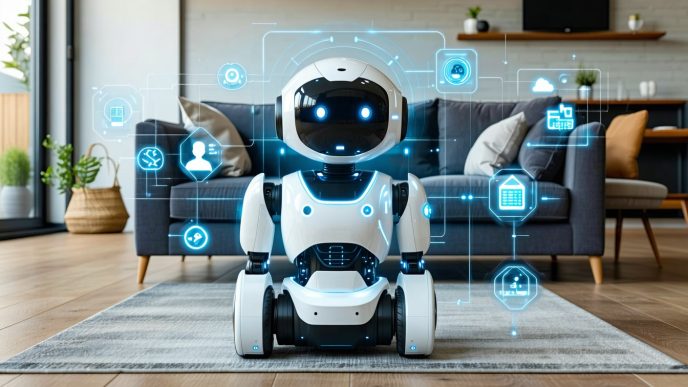Introduction to Home Robots
The Rise of Home Automation
Home automation has become increasingly prevalent in recent years, making everyday tasks easier and more efficient. As technology continues to evolve, the integration of robots into household routines has gained momentum. From cleaning to companionship, home robots are designed to support various aspects of daily life. For those exploring this new frontier, understanding what to know before you buy a robot is essential in making informed decisions.
The surge in home automation can be attributed to advancements in AI and smart technology, which have made robots more accessible and user-friendly. In a landscape where tech-savvy families are eager to enhance their living environments, home automation offers a blend of convenience and innovation. Common applications include cleaning robots, entertainment devices, and security systems, all contributing to a more streamlined lifestyle.
How Home Robots Can Enhance Daily Life
Integrating home robots into daily life can provide numerous benefits. They can save time, reduce manual labor, and often improve overall household efficiency. The following table outlines key advantages of home robots in various areas of life:
| Benefit | Description |
|---|---|
| Time Savings | Robots handle repetitive tasks, freeing up time for family and personal activities. |
| Increased Efficiency | Automated processes result in less time spent on chores and errands. |
| Enhanced Convenience | Easy-to-use interfaces allow for seamless integration with daily routines. |
| Lifestyle Improvement | Companionship robots can offer emotional support and engagement for users. |
| Safety and Security | Robots can monitor homes and alert owners to unusual activity, enhancing security. |
By understanding how these devices can enhance daily routines, potential buyers can better assess their needs and priorities. For more insights on various robot types and capabilities, consider exploring our article on understanding robot types and capabilities.
As the world of home automation continues to grow, being aware of the features, compatibility, and maintenance needs of home robots will help users optimize their experience. Exploring various aspects such as battery life, software updates, and safety measures will further ensure that the integration of robots into their homes is a smooth transition. To learn more about these considerations, visit our resources on robot battery life and charging considerations and robot software updates and upgrades.
Factors to Consider Before Buying
Prior to committing to a home robot, it is essential to take several key factors into account. Understanding personal needs and ensuring compatibility with current smart home devices can have a significant impact on the effectiveness and satisfaction of your new robot.
Understanding Your Needs and Lifestyle
Evaluating individual needs and lifestyle is crucial when choosing a home robot. Different robots serve various purposes, so identifying specific requirements will help narrow down options. For instance:
| Need | Recommended Robot Type |
|---|---|
| Cleaning support | Cleaning Robots |
| Entertainment | Entertainment and Companion Robots |
| Remote assistance | Social Interaction Robots |
Consider factors such as household size, family activities, and daily routines. Identifying high-traffic areas can help determine if a cleaning robot is necessary. For families with children or pets, a robot with enhanced cleaning capabilities might be more suitable. For additional guidance, reference our article on understanding robot types and capabilities.
Compatibility with Existing Smart Home Devices
Ensuring compatibility with existing smart home devices is vital for seamless integration. Many home robots are designed to work with popular smart home systems, allowing for enhanced functionality and convenience.
| Smart Home Feature | Importance |
|---|---|
| Voice Control | Enables hands-free operation |
| App Integration | Centralizes device management |
| Scheduling Capabilities | Automates routines |
Before purchasing, verify that the robot can connect with smart assistants, security systems, or other connected devices already in use. Compatibility not only enhances user experience but also maximizes the robot’s overall benefits. For further information, see our article on robot safety and home compatibility.
By recognizing personal needs and assessing compatibility with smart home devices, potential buyers can make a well-informed decision. This clarity will aid in finding a robot that efficiently fits into their lifestyle and enhances their home experience.
Types of Home Robots
Home robots vary significantly in function and purpose, providing solutions to enhance daily living. It is essential to understand the different types available to make an informed decision. This section will focus on cleaning robots and entertainment and companion robots.
Cleaning Robots
Cleaning robots focus on maintaining cleanliness and hygiene within the home. They offer various functionalities, mainly in the areas of vacuuming and mopping. These devices are designed to reduce the manual labor associated with household chores.
| Feature | Robotic Vacuum Cleaners | Robotic Mop Cleaners |
|---|---|---|
| Primary Function | Vacuuming dust and debris | Mopping hard floors |
| Navigation Capability | Basic to advanced | Basic to advanced |
| Dustbin Capacity | 0.3 – 0.7 liters | 0.2 – 0.5 liters |
| Battery Life | 60 – 120 minutes | 60 – 150 minutes |
| Price Range | $200 – $1,000 | $150 – $600 |
Cleaning robots can integrate with smart home systems, allowing users to control them remotely and set schedules for cleaning, ensuring convenience and efficiency. For insights into battery life considerations, consult our article on robot battery life and charging considerations.
Entertainment and Companion Robots
Entertainment and companion robots provide interaction and engagement. These robots can serve various functions, from entertainment options to companionship for families and children.
| Feature | Entertainment Robots | Companion Robots |
|---|---|---|
| Main Purpose | Games and activities | Emotional support and companionship |
| Interaction Level | High | Moderate to high |
| Features | Music playback, games | Conversation, personality traits |
| Typical Use Case | Family entertainment | Elderly care, children’s play |
| Price Range | $100 – $500 | $200 – $1,500 |
These robots can keep users entertained and provide companionship, particularly for families with children or elderly individuals. Understanding the capabilities of different robots can help in setting realistic expectations for their performance. For further details, explore our article on realistic expectations for robot performance.
Considering the types of home robots available can guide potential purchasers in selecting the right device for their needs. Ensure compatibility with existing systems and take into account maintenance requirements, which can be reviewed in our article on robot maintenance and repair needs.
Features to Look For
When considering the purchase of a home robot, it is essential to evaluate several features that can significantly impact the user experience. Understanding these characteristics can assist in making a well-informed choice. Key features to assess include navigation and mapping capabilities, connectivity options, and privacy and security measures.
Navigation and Mapping Capabilities
Robots equipped with advanced navigation and mapping features are better at understanding their environment. These systems enable robots to create detailed maps of the home, allowing efficient and systematic cleaning or task completion. There are typically two types of navigation:
| Navigation Type | Description |
|---|---|
| Random Navigation | The robot moves in a random pattern and may miss some areas. |
| Smart Navigation | The robot uses sensors and mapping technology to cover the space methodically. |
Smart navigation often includes features such as obstacle detection and avoidance, which can prevent accidents and damage. For detailed insights on different robot types and their capabilities, refer to our article on understanding robot types and capabilities.
Connectivity Options
The ability to connect to the internet and other smart home devices is crucial for enhancing the functionality of a home robot. Many robots support Wi-Fi connectivity, allowing users to control their devices remotely through mobile apps.
| Connectivity Type | Features |
|---|---|
| Wi-Fi | Enables remote control and software updates via apps. |
| Bluetooth | Facilitates local connection to devices, typically over short ranges. |
| Integration with Voice Assistants | Allows operation via voice commands through devices like Amazon Alexa or Google Assistant. |
Connectivity options not only enhance user control but also allow for regular software updates, maintaining optimal performance. Check our article on robot software updates and upgrades for more information about keeping your robot up to date.
Privacy and Security Measures
As home robots often collect and process data, understanding their privacy and security features is essential. Look for robots that provide robust protection measures to safeguard personal information.
| Security Feature | Importance |
|---|---|
| Encryption | Ensures data transmitted between the robot and the app is secure. |
| User Control Settings | Enables personalization of data sharing and privacy preferences. |
| Firmware Security | Regular updates that protect against vulnerabilities and exploits. |
These security aspects help ensure that users can trust their robots to operate safely within their homes. For additional points on ensuring safety and compatibility within your home environment, see our article on robot safety and home compatibility.
Budget and Maintenance Considerations
When considering the purchase of a home robot, understanding the financial implications and maintenance requirements is essential. This section will cover the upfront costs versus long-term value and the necessary upkeep for home robots.
Upfront Costs vs. Long-term Value
The initial investment for a home robot can vary significantly based on the type and features of the device. It’s crucial for potential buyers to weigh these upfront costs against the long-term benefits and savings associated with owning a robot.
| Robot Type | Average Upfront Cost | Expected Lifespan (Years) | Estimated Annual Running Cost |
|---|---|---|---|
| Cleaning Robots | $200 – $1,000 | 3 – 5 | $50 – $100 |
| Entertainment Robots | $100 – $600 | 2 – 4 | $30 – $50 |
| Companion Robots | $150 – $800 | 2 – 5 | $20 – $40 |
The table above illustrates the range of costs associated with different types of home robots. When evaluating these expenses, potential buyers should consider how much time and effort the robot saves in daily life. For thorough insights into various kinds of robots, visit our article on understanding robot types and capabilities.
Maintenance and Upkeep
Maintaining a home robot can require time and investment. Routine care ensures that the robot functions effectively and extends its lifespan. This section highlights the key maintenance aspects to keep in mind.
| Maintenance Task | Frequency | Estimated Cost per Year |
|---|---|---|
| Cleaning Filters and Brushes | Monthly | $20 – $50 |
| Software Updates | As Available | Free or Low-Cost |
| Battery Replacement | Every 1-2 Years | $30 – $100 |
| General Repairs | As Needed | $50 – $200 |
Maintenance tasks included in the table above involve basic upkeep as well as software management, which is crucial for optimal robot performance. Regular maintenance contributes to a robot’s efficiency and effectiveness in completing tasks.
Additional considerations include the availability of warranties and customer support, which can significantly impact long-term satisfaction with a home robot purchase. For more information on these topics, refer to our article on robot warranty and customer support.
Prospective buyers should also be aware of the robot’s battery life and charging needs by exploring robot battery life and charging considerations. Understanding these elements can help in budgeting appropriately and setting realistic expectations for the robot’s performance and usage.
Final Thoughts
Making an Informed Decision
Individuals aiming to purchase a home robot must take several key factors into account before making a commitment. Understanding personal needs and lifestyle is essential in selecting the right device. A robot’s purpose—be it cleaning, companionship, or entertainment—should align with daily routines and preferences.
Compatibility with existing smart home devices is another critical criterion. Potential buyers should verify that their chosen robot can seamlessly integrate with other home automation systems. Ensuring compatibility can significantly enhance the functionality and convenience of the robot.
Price is an important aspect, but the value offered by the robot over its lifespan should also be assessed. Evaluating factors such as maintenance costs, battery life, and long-term upgrades can provide a more comprehensive understanding of the overall investment.
| Consideration | Description |
|---|---|
| Understanding Needs | Assessing specific household tasks and preferences. |
| Compatibility | Checking integration with current smart home devices. |
| Budget | Evaluating initial costs and long-term value. |
| Maintenance | Considering upkeep, software updates, and repair needs. |
For more detailed insights into understanding robot types and capabilities, refer to our article on understanding robot types and capabilities.
Embracing the Future of Home Robotics
Home robotics technology continues to evolve rapidly, enhancing the functionality and efficiency of these devices. As early adopters, buyers will encounter numerous advancements, from improved navigation and mapping to robust privacy and security measures.
Staying informed about trends in the industry can equip potential buyers with knowledge about the latest features and technologies. Regularly considering aspects like battery life, software updates, and safety features ensures that new robotics align with expected household needs.
The decision to invest in a home robot is significant. Buyers should remain realistic about performance expectations. Understanding what a robot can and cannot do creates a positive experience for both the user and the technology. For additional insights on effective integration and setup considerations, explore our articles on robot setup and learning curves and realistic expectations for robot performance.
Adopting home robotics can streamline daily tasks, bringing efficiency and convenience to modern living. As individuals navigate the process of purchasing their first home robot, a thorough understanding of what to know before you buy a robot will lead to a rewarding and enhanced lifestyle.
For inquiries about warranties, customer support, and repair needs, consult our resources on robot warranty and customer support and robot maintenance and repair needs.















